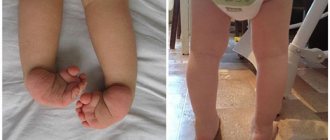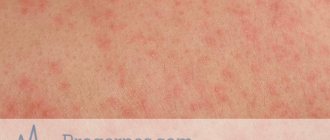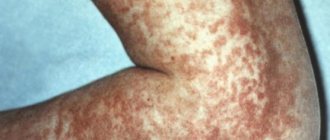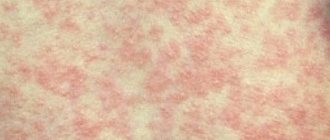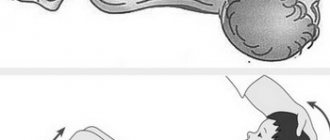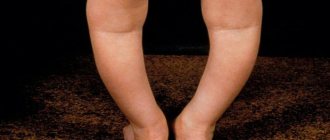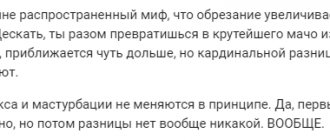What are synechiae?
The fusion of the inner layer of the foreskin with the head of the penis is called synechiae. In most boys, this phenomenon is observed almost from the moment of birth - there are delicate adhesions inside the penis that prevent the head of the penis from emerging.
In the first year of life, only some babies can open the head of the penis either partially or completely. The degree and nature and extent of fusion may vary. Such a fusion can extend from the coronary groove, located on the head, to the opening of the urethra, located outside the penis.
Synechiae are a kind of natural protection, a special mechanism that reduces the risk of infections entering the preputial space, thereby preventing the occurrence of inflammation.
In this case, under the skin of the foreskin, smegma may be found, which is a white formation of a dense cheesy consistency - the secretion of the sebaceous glands. Usually, smegma is easily rejected on its own and does not have any pathological effect on the child’s body.
Reasons for the formation of adhesions
Adhesions in boys can appear for various reasons.
- Infections . Pathogenic microorganisms entering the child’s genitourinary system often lead to the formation of synechiae. If an inflammatory process begins, the result may be fusion of the head with the foreskin. Therefore, if your baby has signs of inflammation on the penis, you need to see a doctor and get tested. The infection can reach the baby in different ways, for example, from parents through clothes, towels, or due to poor hygiene. To prevent this, you need to carefully monitor your child’s things and wash them separately.
- Allergic diseases , oddly enough, can also cause adhesions. If a boy has a severe allergy to any product or substance, it is necessary to frequently check the condition of the penis and foreskin to prevent inflammation.
- Complications of a mother's pregnancy caused by infections can also lead to the formation of adhesions - after birth, the child almost immediately begins to actively form a large number of synechiae, which the body cannot get rid of on its own. Doctors' intervention is necessary. Most expectant mothers monitor their health while carrying a baby, and this form occurs in isolated cases.
Delicate problem: the boy has an inflamed penis
Inflammation of the head and foreskin of the genital organ is a fairly common acquired problem in boys. Despite the fact that the disease looks scary, it is not dangerous for the baby, but in the absence of treatment it becomes chronic.
All future men have physiological phimosis from birth. This is a normal condition in which the head of the reproductive organ is covered by a fold of skin connected to it by adhesions, or synechiae. A cavity forms under the foreskin where smegma accumulates - a mixture of sebaceous gland secretions and desquamated epithelial cells, which is washed out with urine. However, if the synechiae have not completely resolved and the natural cleansing procedure is disrupted, inflammation may develop (we recommend reading: photo of the initial stage of synechiae in girls).
The pathological process most often occurs as a result of injury, infection (including intrauterine), allergies, or an attempt by parents to retract the foreskin ahead of schedule, which leads to a violation of natural protection. The disease manifests itself gradually when more and more pathogenic bacteria accumulate between the head and the fold of skin covering it.
When is treatment required?
Usually, special treatment for synechia of the foreskin is not required, since they gradually separate naturally and open the exit to the head, which usually happens as the boy grows. This process can continue until the beginning of puberty.
During adolescence, thanks to the active production of hormones, the skin of the penis becomes more extensible, acquires elasticity and ceases to create an obstacle for the glans to exit. The elimination of adhesions is also facilitated by spontaneously occurring erections that begin as one grows older.
The separation of synechiae usually occurs spontaneously; various factors contribute to this:
- sudden erections that may occur in boys;
- prepuce;
- enzymes produced by the sebaceous glands.
The degree of adhesions and their length vary in each specific case. In some patients, subtle adhesions may extend to the coronary sulcus and even the urethra.
In urological practice, there are often cases when, when the head has not opened, due to existing accumulations of smegma, an inflammatory process begins, which can be accompanied not only by redness of the foreskin and the head itself, but also by significant swelling, as well as discharge from the prepuce ring.
In this case, the child experiences pain when urinating. This phenomenon is called balanoposthitis, and to eliminate it and successfully treat it, it is necessary to remove the accumulated smegma and purulent formations, and then use special ointments locally, but only a doctor should carry out such a procedure.
Balanoposthitis is considered a pathological condition, which, on the one hand, has a positive aspect in terms of physiology - when the formed smegma is eliminated, the synechiae of the foreskin are usually eliminated (resorption).
But with frequent relapses, the effect can be the opposite - instead of resorption, with improper care, thin adhesions of the foreskin may degenerate into scar formations, which will subsequently lead to the appearance of phimosis. Read more about phimosis in boys →
Removal of synechiae surgically
There is no exact age when the head can independently free itself from adhesions. On average, this occurs at the age of 6-8 years. The help of surgeons is usually resorted to in case of formation of cicatricial phimosis or frequently recurring inflammation. Synechiae are removed surgically even if they have not resolved on their own by the age of 12 years. The operation is performed using local anesthesia.

The purpose of such an operation is to free from existing adhesions not only the head of the penis itself, but also the inside of the foreskin. Sometimes a specially designed probe is used to carry out the procedure.
Under no circumstances should you try to separate adhesions yourself, especially at home. The procedure will be traumatic, extremely painful and cause many complications.
Principles of treatment
Normally, resorption of synechiae and exposure of the head of the penis occurs by 3-6 years. If this does not happen, you need to contact a pediatrician or urologist. Further tactics will depend on the severity of the pathological process. With timely treatment, there is a very high chance of avoiding complications and avoiding surgery.
Conservative treatment
The child should be washed daily with warm water, carefully removing all dirt from the skin of the penis
Conservative therapy involves proper care of the external genitalia. The child should be washed daily with warm water, carefully removing all dirt from the skin of the penis. During bathing, it is recommended to carefully open the head - gently, without effort or pressure. The procedure should not cause pain to the child. After bathing, the skin is wiped dry and lubricated with baby cream. Such simple manipulations help to gradually move the foreskin and eliminate subtle synechiae without harm to the child.
What is important for parents to know?
- Daily hygiene procedures give effect only after 1-3 months. There is no need to force things.
- All manipulations are carried out very carefully and carefully. Traumatization of the foreskin can lead to the development of inflammation and slow down recovery.
- To treat the foreskin, you can use antiseptics (chamomile decoction, an aqueous solution of miramistin or chlorhexidine). It is not recommended to wash with potassium permanganate preparations (potassium permanganate) - you can get a tissue burn with subsequent scarring and the formation of rough adhesions.
- Before carrying out procedures, you should consult your doctor. In some situations, surgical treatment cannot be avoided.
Drug therapy is prescribed for the development of balanoposthitis. Antibacterial drugs will help cope with the infection and remove the source of inflammation. The choice of a specific antibiotic will depend on the causative agent of the disease and the severity of the child’s condition. Until the inflammatory process subsides, no other interventions are performed.
Surgery
The operation to remove adhesions is performed at the age of 10-12 years. Before reaching this age, there is a possibility that synechiae will disappear on its own without surgical intervention. Early excision of adhesions can lead to the development of inflammation and rapid relapse of the disease.
The operation is performed under local anesthesia. During the procedure, the doctor excises the synechiae and creates conditions for free movement of the foreskin. After surgery, anti-inflammatory drugs are prescribed for 7-10 days. If you do not provide proper care for the postoperative area, you can provoke the development of inflammation with further scarring and relapse of the disease.
Hygiene features
After surgery and treatment, mandatory and careful adherence to toilet and personal hygiene rules is required, especially in the first week. Particular attention should be paid to the leaves of the foreskin, where special ointments are placed to create a layer that prevents the fusion of surfaces.
But there are also general rules of hygiene, the observance of which will help to avoid complications and will help solve the problem naturally. The baby's penis must be washed daily with running water, preventing it from entering the preputial sac.
There is no need to try to expose the head of the penis on your own, especially if you have difficulty doing so . This can lead not only to the forced removal of thin protective adhesions and further fusion, but also to pinching of the head, which will require urgent surgery.
It is important not to allow the child to be in full diaper. Diapers should be changed every 6 hours, while providing air baths. This approach will help avoid irritation and inflammation. In hot weather, it is better not to put on a diaper for a boy, since overheating promotes the release of excess sweat and creates an excellent environment for the development of harmful microorganisms.
It is necessary to choose the right underwear for your baby. Briefs should be comfortable, made from natural fabrics, preferably cotton. It is also important to ensure that underwear does not compress or pull on the genitals.
Author: Vaganova Irina Stanislavovna, doctor
Proper hygiene for boys
We recommend reading: Toxic infection in children. How dangerous is it and how to help your child
Author
Irina Vaganova
Doctor
All articles by the author
I like!
A boy has synechiae: is it normal or a reason to visit a doctor?
Synechia is a normal physiological phenomenon that occurs in children of both sexes, so you should not sound the alarm if the boy’s head of the penis is fused with the foreskin (prepuce).
Experts recommend closely monitoring the baby’s development, since this phenomenon, in the presence of certain factors, can acquire the status of a pathology over time. To prevent this, every parent should be able to distinguish physiological synechiae in a boy from pathological ones.
Physiological adhesions
Normally, up to 3 years, the head of the penis should be completely covered by the foreskin. You cannot move it away yourself - this can cause harm to the baby. There is a widespread belief that by periodically moving the foreskin, you can train it, as a result of which, after a certain period of time, the process of natural exposure of the head of the penis will occur much easier. However, this is completely untrue.
In most cases, synechia does not cause any discomfort to the boy and does not manifest itself at all. Hyperemia, itching, swelling and other signs of an infectious process are detected only in case of complications requiring treatment. For clarity, the photograph below shows what a boy’s penis normally looks like at an early age.
Pathological synechiae
If the head of the penis has fused to the foreskin as a result of mechanical damage, this process will be accompanied by severe redness and pain in the groin area. In this case, purulent or cheesy discharge often appears. When synechia occurs, retraction of the foreskin is difficult, the head of the penis is partially or completely closed. If this phenomenon is detected, you should not make a diagnosis yourself. The presence of growth can only be determined by a doctor. In the photo below you can see what the fusion of the head of the penis with the foreskin looks like in boys.
